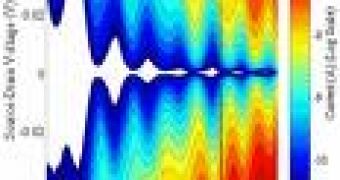Electrons have a negative charge and are glued into atoms by the attractive force of its positively charged nucleus. In classical physics, an electron could not escape from an atom unless it received enough energy to overcome this force by ascending the nucleus' "potential barrier".
But quantum mechanics allows another way: the electron can "tunnel" straight through the barrier with a certain probability. Quantum tunneling is common in the microscopic world. But until now, it has proven impossible to time the process because it happens much faster than any clock could possibly measure.
For the first time, scientists have measured electrons tunneling their way out of atoms. Each escape happened amazingly quickly, in less than a billionth of a millionth of a second.
A laser pulse consists of a small number of electric-field oscillations that can pull the outer electrons of atoms away from their binding nuclei. At the peaks of these oscillations, the pull can be so great that the outer electrons are given a chance to escape (or tunnel) from the atom, even though they don't have enough energy to overcome the attractive pull of the nucleus. But this process occurs so quickly that current instruments can only see the final ionized atom, and not any intermediate states.
Ferenc Krausz and colleagues from the Max-Planck Institut, in Germany, have now found a way around instrument limitations by probing atoms with two pulses of different-wavelength light that are carefully-timed to take snapshots of the tunneling process.
The technique involves probing atoms that have very tightly bound electrons - in this case those of neon - which do not readily ionize with a laser pulse alone. The atoms must first be prepared by an exciting pulse, which sends some of the electrons to outer regions of the atom where tunneling can be induced by an ionizing pulse.
This two-stage process is where the advantage lies: if the exciting pulse has a much shorter wavelength than the ionizing laser pulse, it can be switched on at many points in the ionizing pulse's cycle, and only at these points will electrons be in a position to tunnel. Then, by noting when in the ionizing laser's cycle the electrons tunnel, a picture of how the electrons leave the atom can gradually be reconstructed.
The results proved that a single electron could escape during a half-wave of the infrared laser, fleeing in less than 400 attoseconds - an unimaginably short time. If you slowed down time so that an attosecond (the 18th billionth of a second) lasted for 1 second, that second would last for 30 billion years - more than twice the age of the universe.
The light-induced tunneling technique may now be used to provide further observations of electron movement, giving scientists unprecedented insights in areas such as microelectronics and biological imaging and it could speed up the quest for compact X-ray lasers applications, which could lead to improved early-cancer diagnosis.

 14 DAY TRIAL //
14 DAY TRIAL //